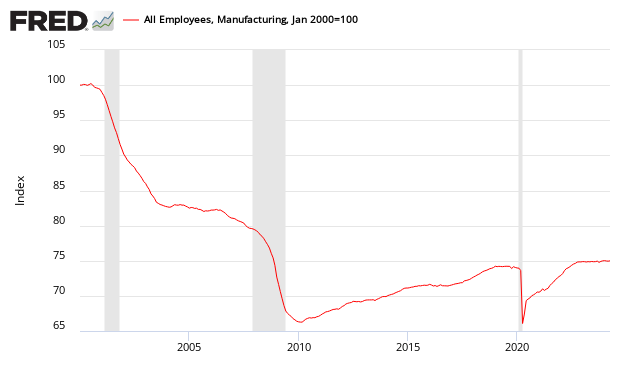Written by Steven Hansen
 The ISM Manufacturing survey continues to indicate manufacturing growth expansion – it again marginally improved this month. The key internal new orders modestly improved and remains in expansion. Backlog of orders returned to contraction.
The ISM Manufacturing survey continues to indicate manufacturing growth expansion – it again marginally improved this month. The key internal new orders modestly improved and remains in expansion. Backlog of orders returned to contraction.
The ISM Manufacturing survey index (PMI) was marginally improved from 52.8 to 53.5 (50 separates manufacturing contraction and expansion). This was slightly above expectations which were 52.8 to 54.0 (consensus 53.2).
Earlier today, the PMI Manufacturing Index was released – from Bloomberg:
Released On 7/1/2015 9:45:00 AM For Jun, 2015
Prior Consensus Consensus Range Actual Level 54.0 53.7 53.4 to 55.2 53.6 Recent History Of This Indicator
The PMI Manufacturing Index has been on the soft side as have most factory indicators. Still, new orders were strong in the flash report despite continuing export troubles tied to the strong dollar.
This ISM Manufacturing index had been in a general uptrend since mid 2013, the three month trend is now improving. This is the 30th month of expansion. The regional Fed manufacturing surveys indicated little growth or contraction in June, and now the ISM indicates manufacturing shows weak expansion.

Relatively deep penetration of this index below 50 has normally resulted in a recession.
The noisy Backlog of Orders returned to contraction. Backlog growth should be an indicator of improving conditions; a number below 50 indicates contraction. Backlog accuracy does not have a high correlation against actual data.
Excepts from the ISM release:
Economic activity in the manufacturing sector expanded in May for the 29th consecutive month, and the overall economy grew for the 72nd consecutive month, say the nation’s supply executives in the latest Manufacturing ISM® Report On Business®.
“The May PMI® registered 52.8 percent, an increase of 1.3 percentage points over the April reading of 51.5 percent. The New Orders Index registered 55.8 percent, an increase of 2.3 percentage points from the reading of 53.5 percent in April. The Production Index registered 54.5 percent, 1.5 percentage points below the April reading of 56 percent. The Employment Index registered 51.7 percent, 3.4 percentage points above the April reading of 48.3 percent, reflecting growing employment levels from April. Inventories of raw materials registered 51.5 percent, an increase of 2 percentage points from the April reading of 49.5 percent. The Prices Index registered 49.5 percent, 9 percentage points above the April reading of 40.5 percent, indicating lower raw materials prices for the seventh consecutive month. Comments from the panel carry a positive tone in terms of an improving economy, increasing demand, and improving flow of goods through the West Coast ports. Also noted; however, are continuing concerns over the price of the US dollar and challenges affecting markets related to oil and gas industries.”
Of the 18 manufacturing industries, 14 are reporting growth in May in the following order: Apparel, Leather & Allied Products; Furniture & Related Products; Paper Products; Food, Beverage & Tobacco Products; Nonmetallic Mineral Products; Plastics & Rubber Products; Electrical Equipment, Appliances & Components; Primary Metals; Transportation Equipment; Printing & Related Support Activities; Fabricated Metal Products; Machinery; Miscellaneous Manufacturing; and Chemical Products. The two industries reporting contraction in May are: Textile Mills; and Computer & Electronic Products.

It is interesting to note that ISM Manufacturing represents less than 10% of USA employment, and approximately 20% of the business economy. Historically, it could be argued that the production portion of ISM Manufacturing leads the Fed’s Industrial Production index – however the correlation is not strong when looking at trends.

New orders have direct economic consequences – and improved from 55.8 to 56.0. Expanding new orders is a relatively reliable sign a recession is NOT imminent. However, New Orders contraction have given false recession warnings twice since 2000.

However, holding this and other survey’s Econintersect follows accountable for their predictions, the following graph compares the hard data from Industrial Products manufacturing subindex (blue bar) and US Census manufacturing shipments (red bar) to the ISM Manufacturing Survey (purple bar).
Comparing Surveys to Hard Data

z survey1.png
Caveats on the use of ISM Manufacturing Index:
This is a survey, a quantification of opinion – not facts and data. However, as pointed out above, certain elements of this survey have good to excellent correlation to the economy. Surveys lead hard data by weeks to months, and can provide early insight into changing conditions.
Many use ISM manufacturing for guidance in estimating manufacturing employment growth. Econintersect has run correlation coefficients for the ISM manufacturing employment and the BLS manufacturing employment data series above going back to 1988, using quarterly data. The coincident correlations are actually negative, but poor (r = -0.2 to -0.4 for various time periods examined). See here for definitions.
Before 2000 the ISM employment data had a weak positive correlation to the BLS data 4 to 7 quarters later (r values above 0.6). Since 2000 the correlations for ISM manufacturing employment as a leading indicator for the BLS manufacturing employment have been between 0 and 0.3 for r (correlation coefficient). These values define correlations as none to poor.
In other words, ISM employment index is not useful in understanding manufacturing jobsgrowth. The graph below shows BLS manufacturing employment month-over-month gains against the ISM Manufacturing employment index.
Indexed to Jan 2000 – Comparison of the ISM Manufacturing Employment Subindex (blue line) to BLS Manufacturing Employment (red line) – all data seasonally adjusted

The ISM employment index appears useful in predicting turning points which can lead the BLS data up to one year.
Related Posts:
Old Analysis Blog | New Analysis Blog |
| Institute of Supply Management Surveys | Institute of Supply Management Surveys |
include(“/home/aleta/public_html/files/ad_openx.htm”); ?>







